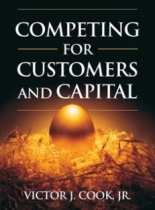Tough Choices, Bad Board
IT REALLY ISN'T MARKETING
In the fall semester of 2004 I offered an MBA course at Tulane University based on the 3rd revision of the pre-publication manuscript of my book. This was about the 4th running of the course in both the undergraduate and graduate programs.
The course was cross-listed for credit in marketing, accounting, and finance concentrations at the Freeman School of Business. It was the only marketing course in the history of the school ever cross-listed for credit in accounting and finance. It may have been the only one in the world. Thirty-seven students took the course. Most of them were accounting and finance majors. Marketing students knew they had to work with dreaded financial accounting data online from WRDS (Wharton Research Data Services). Word on the street was "Cook's course really isn't marketing."
YOUR DESKTOP REVISITED
In that semester nine teams of MBA students updated analyses in my book. One of these teams worked on the strategic group in Chapter 6 on The Battle for Your Desktop. The companies in this group were Compaq, Dell, Hewlett-Packard, and IBM. The analysis covered the years from 1991 through 2000 – the pre-merger period. Their job was to update it from the 1st quarter of 2002 through the 2nd quarter of 2004 (the most recent data for all firms available in the fall of 2004).
Dell was the focus of this team's report. But since they ran the numbers on all four companies, they couldn't help but notice an apparent inconsistency in the results for HPQ: the company's "relative earnings productivity" under Carly Fiorina's leadership continued to improve after the merger, hitting 98.7% in the 4th quarter of 2003. Relative earnings productivity is a measure of the degree to which a company achieves maximum potential earnings. Yet, investors drove HP's value/revenue multiple down from 9.3 in her first year as CEO to just 2.8 in the 2nd quarter of 2004. See my last post "Carly Delivered While Investors Fiddled."
HP's NORTHWEST DRIFT
Roughly speaking my theory of Competitive Stock Valuation asserts that earnings productivity and the value/revenue ratio are positively correlated. Or, if the quality of earnings is increasing, so should a company's value/revenue ratio.
Picture a scatter diagram with relative earnings productivity on the vertical axis and the value/revenue multiple on the horizontal axis. Over time you should see these metrics move toward the upper right-hand corner of the chart. In other words, a "Northeast Drift" in these numbers. HPQ was exhibiting a strong "Northwest Drift" – exactly the opposite of my prediction. The team, and the entire class since all their results were projected on huge screens in the front of the classroom, wanted me to explain this result. Here is what I told them in 2004:
Considering the bad press Ms. Fiorina continued to receive and investor’s failure to reward the company’s performance under her leadership this appears to be case of bad PR coupled with poor investor relations (Competing for Customers and Capital, page 239).
Of course, the MBA students concluded my theory failed a critical test. One of them asked "How can bad press and poor investor relations disregard the facts?" I really wasn't able to answer that question until yesterday, when I read Carly Fiorina's book cover to cover.
TOUGH CHOICES, BAD BOARD
What I failed to understand about HP's problem was that the bad PR and poor investor relations were not being driven by the unseen-hand of the market:
Although not everyone could yet see it, by the end of 2004, a sustainable, successful business transformation had been achieved. It wasn't perfect, but it was perfect enough. … The only clouds on the horizon were the press and the stock price. These were not insignificant, but I believed that the strong performance we would deliver over the coming year would take care of both in time (pages 275-276).
The PR and investor relation problems were the product of several seriously dysfunctional members of HP's own Board of Directors. To find out what happened you've got read the details for yourself, but I can point to an event that occurred after the January, 2005 off-site Board meeting which documents their dysfunctional behavior. In her book Carly reports:
The following Friday afternoon I received an urgent phone call from one of our press people. The Wall Street Journal was going to print a detailed story the next Monday morning about our Board meeting. The reporter was talking to at least two, possibly three, Board members. Was it true we were going to reorganize? Did I have a comment?
It is hard to convey how violated I felt. Until a Board makes a decision, its deliberations are confidential. Whoever had done this had broken a bond of trust with me and every other Board member. … Trust is a business imperative. No Board or management team can operate effectively without it (page 290).
That article appeared in the Jaunary 24, 2005 issue of the Journal. Here's what it said:
At its annual planning meeting between Jan. 12 and Jan. 15, H-P's board discussed giving three senior executives more authority and autonomy over key operating units, according to people familiar with the matter. The board also has asked Thomas Perkins, a prominent venture capitalist and a former H-P director, to rejoin the board, these people said.
The next time I teach my course, Carly Fiorina's book Tough Choices: a Memoir will be required reading. It's that important in understanding how the competition for customers and capital really works, at a personal level. The next time you find yourself frustrated and angered by the self-destructive behavior of those who care more about themselves than the future of your organization, just stop and read Carly's book.
~V


